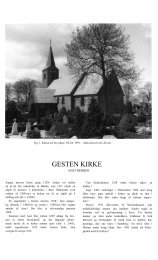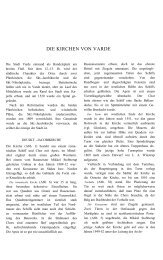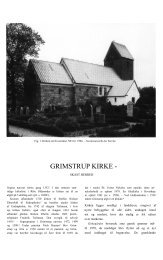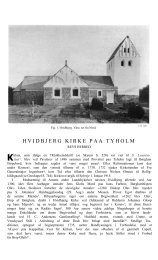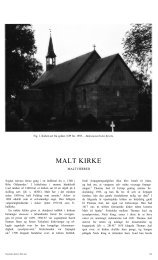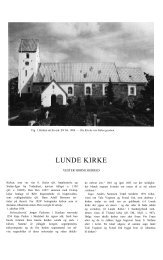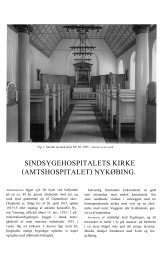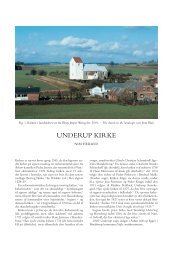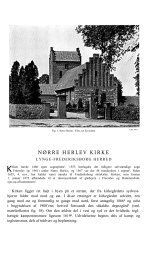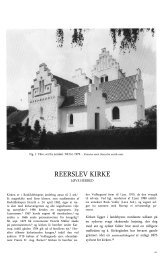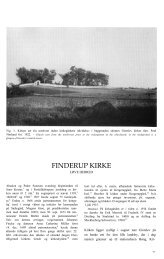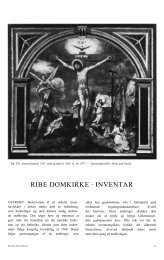SKT. NIKOLAJ KIRKE - Danmarks Kirker - Nationalmuseet
SKT. NIKOLAJ KIRKE - Danmarks Kirker - Nationalmuseet
SKT. NIKOLAJ KIRKE - Danmarks Kirker - Nationalmuseet
Create successful ePaper yourself
Turn your PDF publications into a flip-book with our unique Google optimized e-Paper software.
810 KOLDING <strong>SKT</strong>. <strong>NIKOLAJ</strong> <strong>KIRKE</strong><br />
The eighteenth century is also represented by<br />
paintings of the parish priest Carsten Volquartz<br />
and his wife Margrethe from c. 1775, the nineteenth<br />
by the Twelve Bell, donated in 1840 by<br />
Jens Peter Wissing, and a chandelier from 1880,<br />
which bears the names of the same Jens Peter<br />
Wissing (posthumously) and of S. Svensson as the<br />
churchwarden. The pews are from 1908.<br />
Colour scheme and refurbishings. The church interior<br />
acquired its present appearance in the most<br />
recent restoration of 1975-77, when most of the<br />
historical furnishings were repaired and a succession<br />
of treatments of the other items was launched.<br />
The interior is dominated by rich Renaissance<br />
colouring, most authentic on the altarpiece. Particularly<br />
worth singling out are the fine paintings<br />
from the reign of Christian IV, which are further<br />
supplemented by a number of painted sepulchral<br />
tablets. The names of painters cannot be ascribed<br />
with certainty to any of the works, but it seems<br />
reasonable in the case of the altarpiece to mention<br />
the Hans Kjær (Paludanus), ‘painter to His<br />
Royal Majesty’, who died in 1590 and has his<br />
small sepulchral tablet (no. 6) from 1616 in the<br />
chancel. For the painting on the sepulchral tablet<br />
no. 4 from 1599, Jutland’s great Renaissance<br />
painter Lauritz Andersen Riber has been proposed.<br />
The more recent furnishings are in subdued<br />
tones with a fondness for polished wood.<br />
As early as 1560 the church acquired an †organ,<br />
and over the subsequent decades †pews were<br />
installed, arranged in the usual urban fashion by<br />
rank with the pews of the King and the Lord<br />
Lieutenant at the front, followed by ‘mayors,<br />
alderman and other citizens by rank and class’.<br />
Probably in 1638, when the church was given<br />
a high (†)chancel rail, the pulpit was given an<br />
unusual place above its centre; a position that was<br />
paralleled for example in the church in Kristianstad<br />
in Scania. From the period around 1700 the<br />
strict ranking of the pews began to break up, as<br />
several of the city’s better-off families now established<br />
cabin-like ‘closed pews’ with windows<br />
through which they could observe the service in<br />
splendid isolation. However, the number of the<br />
closed †pews never grew large: in 1746 it was<br />
stated as eight.<br />
The rebuilding of the church after this also led<br />
to an extensive restoration in 1753-58 of the furnishings.<br />
In the rebuilt nave four new rows of<br />
†pews were set up as well as two in each of the<br />
chapels. To these were added a new †organ loft in<br />
the west with a new †organ (no. 2); for its casing<br />
Bishop H. A. Brorson wrote a commemorative<br />
poem on the restoration.<br />
In 1780 an agreement was reached whereby<br />
several valuable vestments and cloths were borrowed<br />
from the Castle Chapel at Koldinghus, for<br />
example the altarcloth from 1719 and two chasubles<br />
from c. 1600 and 1719 (nos. 2-3). The loan<br />
meant that these items were saved from the fire<br />
in the Castle Chapel in 1808, and that they could<br />
be kept in Skt. Nikolaj.<br />
In 1815 the North Chapel was separated from<br />
the church by a wall and furnished as a school;<br />
the baptismal font was given its place in front of<br />
the wall. After the possibility of moving the pulpit<br />
was tried out in 1781 and 1819 (using a test<br />
pulpit!) the pulpit was finally taken down from<br />
the chancel rail in 1823 and set up on the easternmost<br />
pillar on the north side.<br />
In 1858 the North Chapel was once more<br />
incorpo rated in the church. On the same occasion<br />
the pulpit and font were given their present<br />
positions (cf. fig. 106), and a new organ was procured<br />
(†no. 3), built by Demant & Søn, Odense.<br />
In 1876 a wish was expressed to paint the<br />
church pews in the same brown colour as the<br />
choir stalls and the organ, since their white paintwork<br />
from 1852 was ‘difficult to keep clean because<br />
of the smoke from the new heating apparatus’.<br />
After the doors of the pews had been<br />
removed they were therefore given an oak colour<br />
which was to spread to almost all the furnishings<br />
with the rebuilding of 1885-86.<br />
In 1893 Professor Magnus-Petersen carried<br />
out the earliest antiquarian restoration, giving the<br />
altarpiece and pulpit their present appearance.<br />
SEPULCHRAL MONUMENTS. The church<br />
is one of the richest in sepulchral monuments in<br />
Jutland. Of the 15 preserved sepulchral tablets and<br />
memorial tablets a large proportion are from the<br />
Renaissance period. Three are of carved wood



